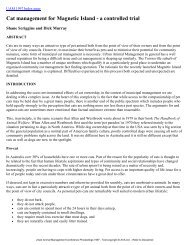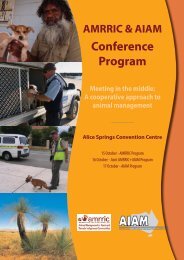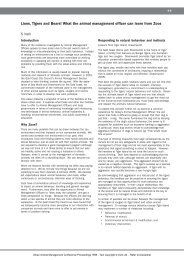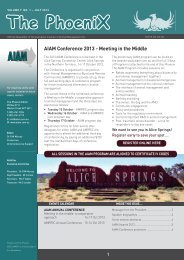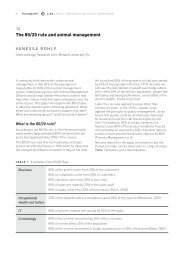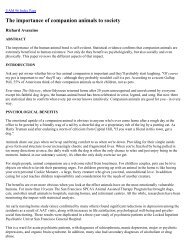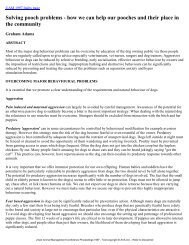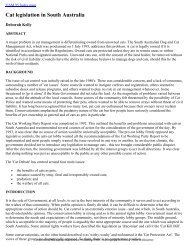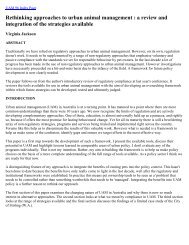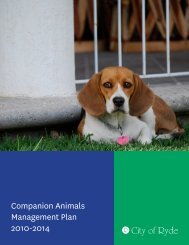Proceedings OF ThE - Australian Institute of Animal Management Inc
Proceedings OF ThE - Australian Institute of Animal Management Inc
Proceedings OF ThE - Australian Institute of Animal Management Inc
You also want an ePaper? Increase the reach of your titles
YUMPU automatically turns print PDFs into web optimized ePapers that Google loves.
100 <strong>Proceedings</strong> 2012<br />
AIAM Annual Conference on <strong>Animal</strong> <strong>Management</strong><br />
19<br />
<strong>Animal</strong> <strong>Management</strong>, Local Government and Dog Aggression: The<br />
imperative <strong>of</strong> understanding canine behaviour and the subsequent<br />
improvement <strong>of</strong> animal management operating procedures<br />
Dr Joanne Righetti<br />
<strong>Animal</strong> Behaviourist<br />
Dog aggression can be a problem for dogs, for<br />
dog owners and for those who have to deal with its<br />
consequences in society. Understanding the biology<br />
<strong>of</strong> canine aggression and then implementing relevant<br />
management, prevention and solutions will reduce<br />
the incidences <strong>of</strong> dog aggression.<br />
Canine aggressive behaviour is the expression <strong>of</strong><br />
the emotional states <strong>of</strong> anger or fear, occurring<br />
due to a combination <strong>of</strong> genetic, physiological and<br />
environmental influences. Some dogs are more<br />
likely to be aggressive due to factors such as pain or<br />
other medical conditions; due to lack <strong>of</strong> experience <strong>of</strong><br />
particular situations or negative experiences: due to<br />
the provision (or perception) <strong>of</strong> limited resources: or<br />
due to redirected or attention-seeking situations.<br />
For the pet owner and animal behavioural<br />
pr<strong>of</strong>essional, solving aggression problems involves<br />
a combination <strong>of</strong> short-term management solutions<br />
and long-term therapies. The reduction <strong>of</strong> canine<br />
aggression in society requires a long term strategic<br />
approach combining many stakeholders including<br />
dog breeders, pet owners, animal pr<strong>of</strong>essionals,<br />
government bodies, researchers and the general<br />
public.<br />
Paper<br />
Dogs are faithful companion animals. Their<br />
willingness to defend us, our property and our<br />
resources may endear them to us but can, at times,<br />
make life difficult. On occasion dogs may display a<br />
growl, a lunge, a bite or even a full-scale dog attack.<br />
This behaviour then becomes a problem for owners<br />
and for society to deal with.<br />
Understanding the biology <strong>of</strong> canine aggression<br />
including its definition, causes and measurement,<br />
then implementing relevant management, prevention<br />
and solutions will reduce the incidences <strong>of</strong> dog<br />
aggression.<br />
Canine Aggression<br />
Aggression identified<br />
Aggression can be defined as behaviour that has the<br />
intention <strong>of</strong> inflicting physical damage on another<br />
individual. When the interests <strong>of</strong> two or more<br />
individuals conflict, the potential for aggressive<br />
behaviour exists (Righetti, 2012).<br />
Aggression is identified in a variety <strong>of</strong> ways, both<br />
by owners and by animal behaviour specialists.<br />
Definitions <strong>of</strong> aggression types may be based on:<br />
• yThe subject (owner-directed aggression, dog-todog<br />
aggression, stranger aggression);<br />
• yThe situation (territorial aggression, food-related<br />
aggression, predatory aggression, maternal<br />
aggression, social aggression);<br />
• yThe emotions and intentions <strong>of</strong> the dog (fearrelated<br />
aggression, dominance aggression;<br />
status-related aggression, pain-related<br />
aggression);<br />
• yThe underlying cause (medically related<br />
aggression, fearful aggression, resource related<br />
aggression, redirected aggression).<br />
An aggressive canine encounter can frighten or<br />
traumatise the victim, injure or even result in<br />
death. Aggressive behaviour is, however, a normal<br />
part <strong>of</strong> life for many animals and is a successful<br />
evolutionary strategy, as it helps animals defend<br />
their resources. It is, however, rarely tolerated in<br />
human society.<br />
Aggression explained<br />
Aggression is an outward expression <strong>of</strong> a dog’s<br />
intense emotions – emotions such as anger or<br />
fear. These feelings alert animals to a potentially<br />
threatening situation and they may also be felt to<br />
lesser extents as dislike, wariness, displeasure,<br />
or irritation. The emotions themselves, although<br />
they may cause severe internal stress, are rarely<br />
dangerous to others. It is when the animal acts on<br />
their emotions that danger may result.



